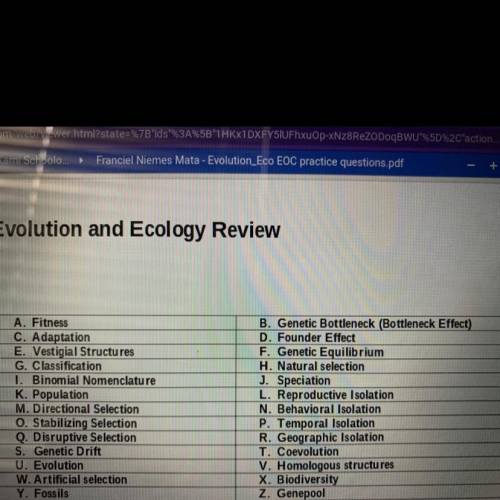
1.__ A pattern in which species influence each other's evolution and therefore evolve in tandem.
2.__a characteristic which helps an organism survive in a specific habitat.
3.__Evolutionary process by which certain beneficial traits becomes more common within a
population, changing the characteristics (traits) of a species over time.
4.__The variety of life and its processes, including the
variety of living organisms, the genetic
differences among them, and the communities and ecosystems which they populate.
5.__the change in species over time.
6.__Animal or plant breeding done by artificially choosing which individuals will reproduce according
to desirable traits.
7.__The preserved remains or traces of organisms; fossils provide extremely rare but vivid windows to
the past.
8.__Structures which descended (evolved) from the same structure within a common ancestor; they
may or may not serve the same function.
9.__Structures which are reduced and perhaps even nonfunctional in one species, but homologous to
functional structures in a closely related species.
10.__The ability of an organism with a certain genotype to survive and reproduce; it is often measured
as the proportion of that organism's genes in all of the next generation's genes.
11.__The complete set of unique alleles in a species or population.
12.__A group of individuals of a single species that mate and interact with one another in a limited
geographic area.
13.__State of a population in which allele and genotype frequencies remain constant from one
generation to the next -a non-evolving population.
14.__The loss of diversity resulting from a drastic reduction in population size and subsequent genetic
drift.
15.__The loss of genetic diversity resulting from colonization of a new area by a small group of
individuals who have broken off from a larger population.
16.__Random changes in allele frequencies in small populations.


Answers: 1
Another question on Biology

Biology, 22.06.2019 03:00
Which set of characteristics best describes sedimentary rock? a) largest type of rock, made of organic matter, hardest type of rock b) often contains layers, forms near sources of water, contains fossils c) least abundant type of rock, made of other rocks, made mostly of minerals d) most abundant type in earth's crust, made of magma/lava, contains no fossils
Answers: 2

Biology, 22.06.2019 07:00
How would you describe the the organisms in the second row of model 1 that are connected to the parents by a line
Answers: 3

Biology, 22.06.2019 11:00
Membrane vesicles containing an internal sodium chloride (nacl) concentration of 0.14 m are placed into separate beakers each containing a different solution. the first beaker contains 0.14 m sucrose, while the second beaker contains 0.14 m calcium chloride (cacl2). the temperature is 25°c. what is the solute potential inside the vesicles, expressed in units of mpa?
Answers: 2

Biology, 22.06.2019 12:00
Why is it to call the calvin cycle the light independent reactions vs the dark reactions
Answers: 3
You know the right answer?
1.__ A pattern in which species influence each other's evolution and therefore evolve in tandem.
2....
Questions




Mathematics, 16.11.2020 22:10



Social Studies, 16.11.2020 22:10

Mathematics, 16.11.2020 22:10

English, 16.11.2020 22:10




History, 16.11.2020 22:10

Advanced Placement (AP), 16.11.2020 22:10

Mathematics, 16.11.2020 22:10

Mathematics, 16.11.2020 22:10

Mathematics, 16.11.2020 22:10


Mathematics, 16.11.2020 22:10



